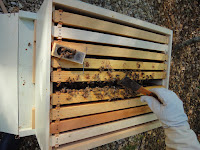I began the morning with another inspection of the Sasha hive to look for the queen. Even with the excluders in place to keep her confined, I could not find her. You know me... I'd rather know where she is instead of where she is not, so with the help of the husband we moved the entire hive around the corner out of sight and, leaving an empty box back at the hive, we brushed off every frame. The theory being that the bees would return to the hive and the queen, if she was in the hive to begin with would be brushed off and left behind as she cannot fly. Nearly every bee made its way back to the hive and no queen was spotted among those left on the ground.

The queens arrived in small cages with 4-5 attendants in each and a candy plug for food. If you look closely in the left-hand cage, you can spot the new queen with a white mark on her back. It will take about 3 days for the attendants to eat though the candy which will then allow access to a hole in the top of the cage. The queen will simply crawl out and hopefully, begin to lay eggs. The time it takes to eat through the candy is important because it allows the other bees in the hive to accept her as their new queen. If the queen were released directly into the hive the bees would think her an intruder, ball her and kill her.
 |
| New queen cage placed in hive. |
Once all the frames were cleared of bees and back in box, we placed the queen cage between two frames with the hole facing up. If the hole were facing down and any of the queens attendants died, their bodies could potentially block the hole and prevent the queen from emerging.
It took only moments for the bees to cover the cage, thinking she's an intruder. Fingers crossed that she is accepted. I'll wait a week and then check to see that she's emerged and has begun laying eggs.
 |
| Rookie Dmitry Orlov |
The other queen was used to make a split from the OV hive, adding a third hive in the apiary. This hive will be known as the Dmitry hive, named after another Russian hockey player for the Washington Capitals.
I pulled out three frames of mostly covered brood and house bees and placed them in a box with drawn comb. There was a big difference in how this hive basically ignored the queen cage. I put the top feeder on and will check again in a week to see if the queen has emerged and has begun laying.
While I was selecting the frames I wanted from the OV hive, I easily found the queen. This hive has been my strong hive, doing all the right things at the right time. I'm hoping that by requeening the Sasha hive and creating the Dmitry hive with a good queen, these hive will bring the apiary into full honey production next year. :-)








